Child Abuse and Neglect: Data Collection, Analysis, and Findings
VerifiedAdded on 2020/06/05
|5
|840
|153
Report
AI Summary
This report delves into the crucial topic of child abuse and neglect, outlining various data collection methods employed in research. It discusses the use of interviews, questionnaires, observations, focus groups, and document analysis as primary techniques for gathering information. The report highlights the photo-voice study as a method for representing and improving society through photographic techniques, emphasizing the importance of clear pictures and a limited participant count. Furthermore, it explains the data analysis process, including the percentage of individuals affected by child abuse and neglect based on surveys, along with the analysis of photographic evidence. The conclusion emphasizes the significance of surveys and photography in aiding recovery from child abuse and neglect. Finally, the report provides a list of relevant references from books and journals supporting the research.
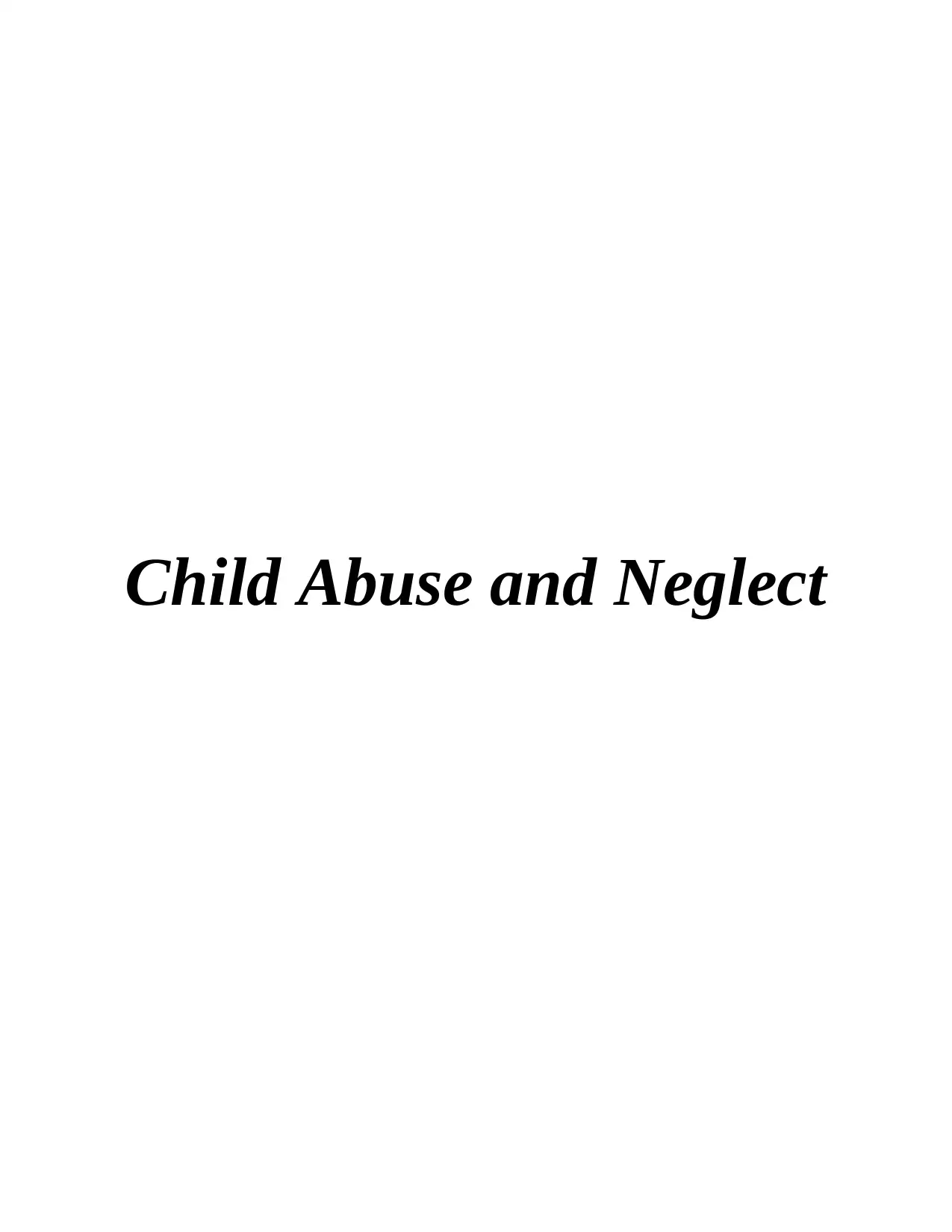
Child Abuse and Neglect
Paraphrase This Document
Need a fresh take? Get an instant paraphrase of this document with our AI Paraphraser
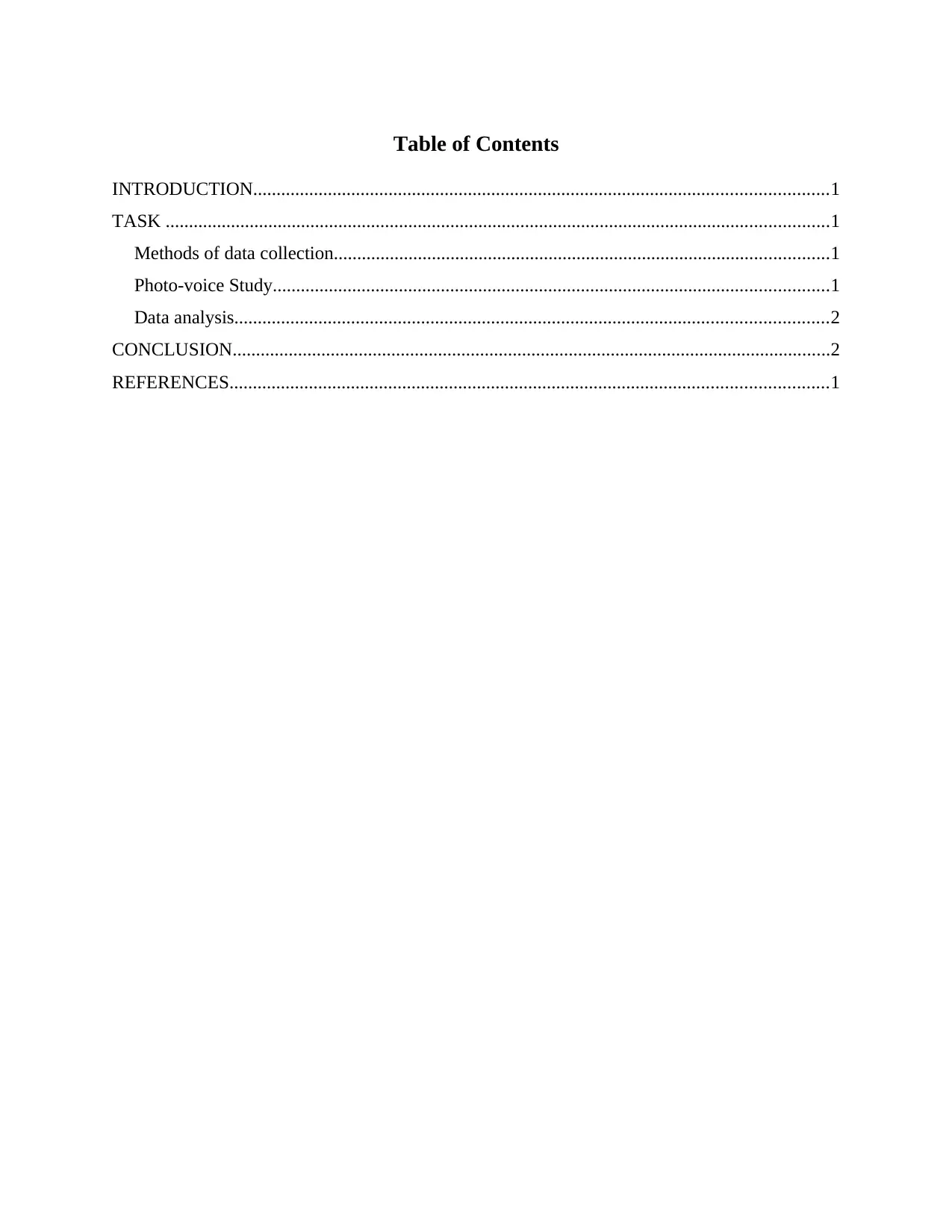
Table of Contents
INTRODUCTION...........................................................................................................................1
TASK ..............................................................................................................................................1
Methods of data collection..........................................................................................................1
Photo-voice Study.......................................................................................................................1
Data analysis...............................................................................................................................2
CONCLUSION................................................................................................................................2
REFERENCES................................................................................................................................1
INTRODUCTION...........................................................................................................................1
TASK ..............................................................................................................................................1
Methods of data collection..........................................................................................................1
Photo-voice Study.......................................................................................................................1
Data analysis...............................................................................................................................2
CONCLUSION................................................................................................................................2
REFERENCES................................................................................................................................1
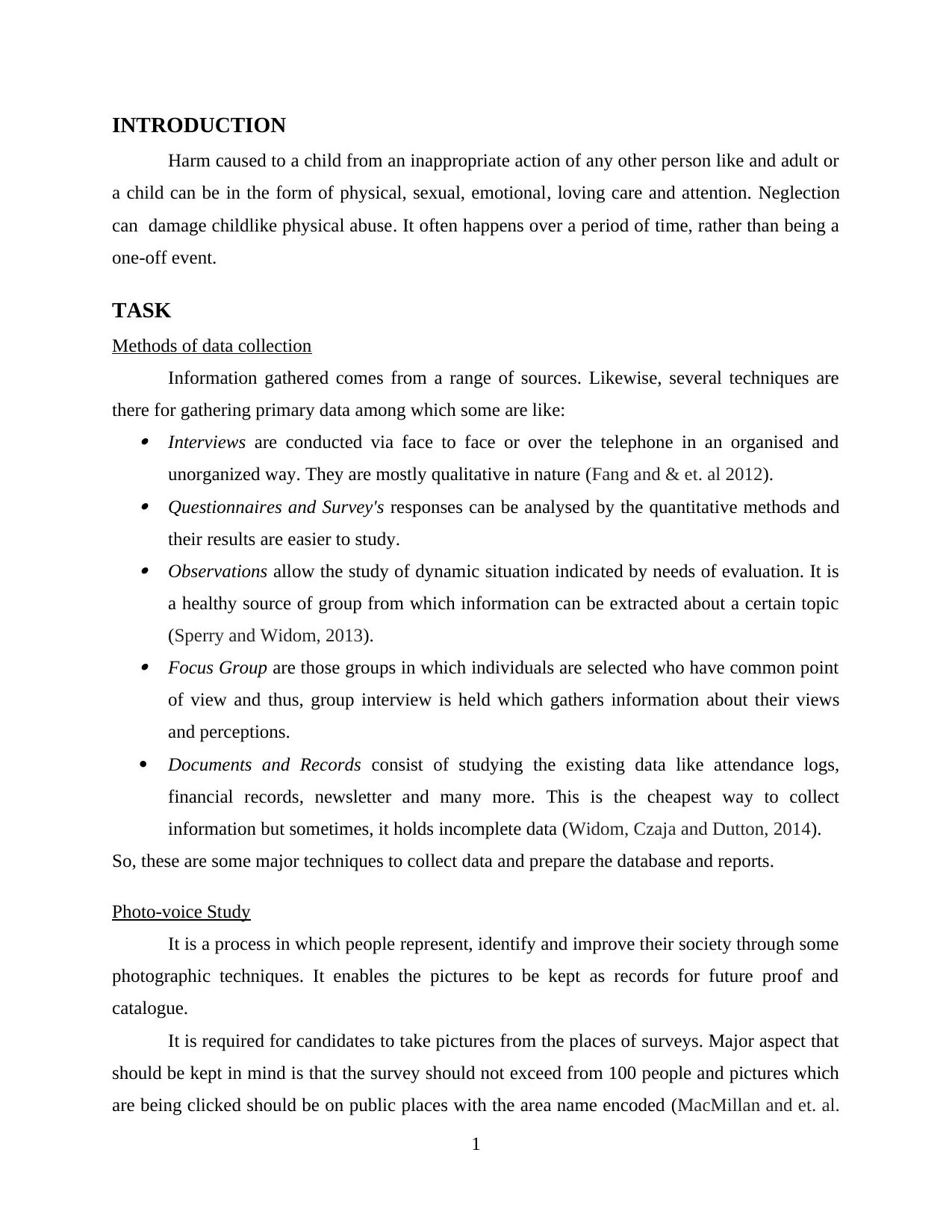
INTRODUCTION
Harm caused to a child from an inappropriate action of any other person like and adult or
a child can be in the form of physical, sexual, emotional, loving care and attention. Neglection
can damage childlike physical abuse. It often happens over a period of time, rather than being a
one-off event.
TASK
Methods of data collection
Information gathered comes from a range of sources. Likewise, several techniques are
there for gathering primary data among which some are like: Interviews are conducted via face to face or over the telephone in an organised and
unorganized way. They are mostly qualitative in nature (Fang and & et. al 2012). Questionnaires and Survey's responses can be analysed by the quantitative methods and
their results are easier to study. Observations allow the study of dynamic situation indicated by needs of evaluation. It is
a healthy source of group from which information can be extracted about a certain topic
(Sperry and Widom, 2013). Focus Group are those groups in which individuals are selected who have common point
of view and thus, group interview is held which gathers information about their views
and perceptions.
Documents and Records consist of studying the existing data like attendance logs,
financial records, newsletter and many more. This is the cheapest way to collect
information but sometimes, it holds incomplete data (Widom, Czaja and Dutton, 2014).
So, these are some major techniques to collect data and prepare the database and reports.
Photo-voice Study
It is a process in which people represent, identify and improve their society through some
photographic techniques. It enables the pictures to be kept as records for future proof and
catalogue.
It is required for candidates to take pictures from the places of surveys. Major aspect that
should be kept in mind is that the survey should not exceed from 100 people and pictures which
are being clicked should be on public places with the area name encoded (MacMillan and et. al.
1
Harm caused to a child from an inappropriate action of any other person like and adult or
a child can be in the form of physical, sexual, emotional, loving care and attention. Neglection
can damage childlike physical abuse. It often happens over a period of time, rather than being a
one-off event.
TASK
Methods of data collection
Information gathered comes from a range of sources. Likewise, several techniques are
there for gathering primary data among which some are like: Interviews are conducted via face to face or over the telephone in an organised and
unorganized way. They are mostly qualitative in nature (Fang and & et. al 2012). Questionnaires and Survey's responses can be analysed by the quantitative methods and
their results are easier to study. Observations allow the study of dynamic situation indicated by needs of evaluation. It is
a healthy source of group from which information can be extracted about a certain topic
(Sperry and Widom, 2013). Focus Group are those groups in which individuals are selected who have common point
of view and thus, group interview is held which gathers information about their views
and perceptions.
Documents and Records consist of studying the existing data like attendance logs,
financial records, newsletter and many more. This is the cheapest way to collect
information but sometimes, it holds incomplete data (Widom, Czaja and Dutton, 2014).
So, these are some major techniques to collect data and prepare the database and reports.
Photo-voice Study
It is a process in which people represent, identify and improve their society through some
photographic techniques. It enables the pictures to be kept as records for future proof and
catalogue.
It is required for candidates to take pictures from the places of surveys. Major aspect that
should be kept in mind is that the survey should not exceed from 100 people and pictures which
are being clicked should be on public places with the area name encoded (MacMillan and et. al.
1
⊘ This is a preview!⊘
Do you want full access?
Subscribe today to unlock all pages.

Trusted by 1+ million students worldwide
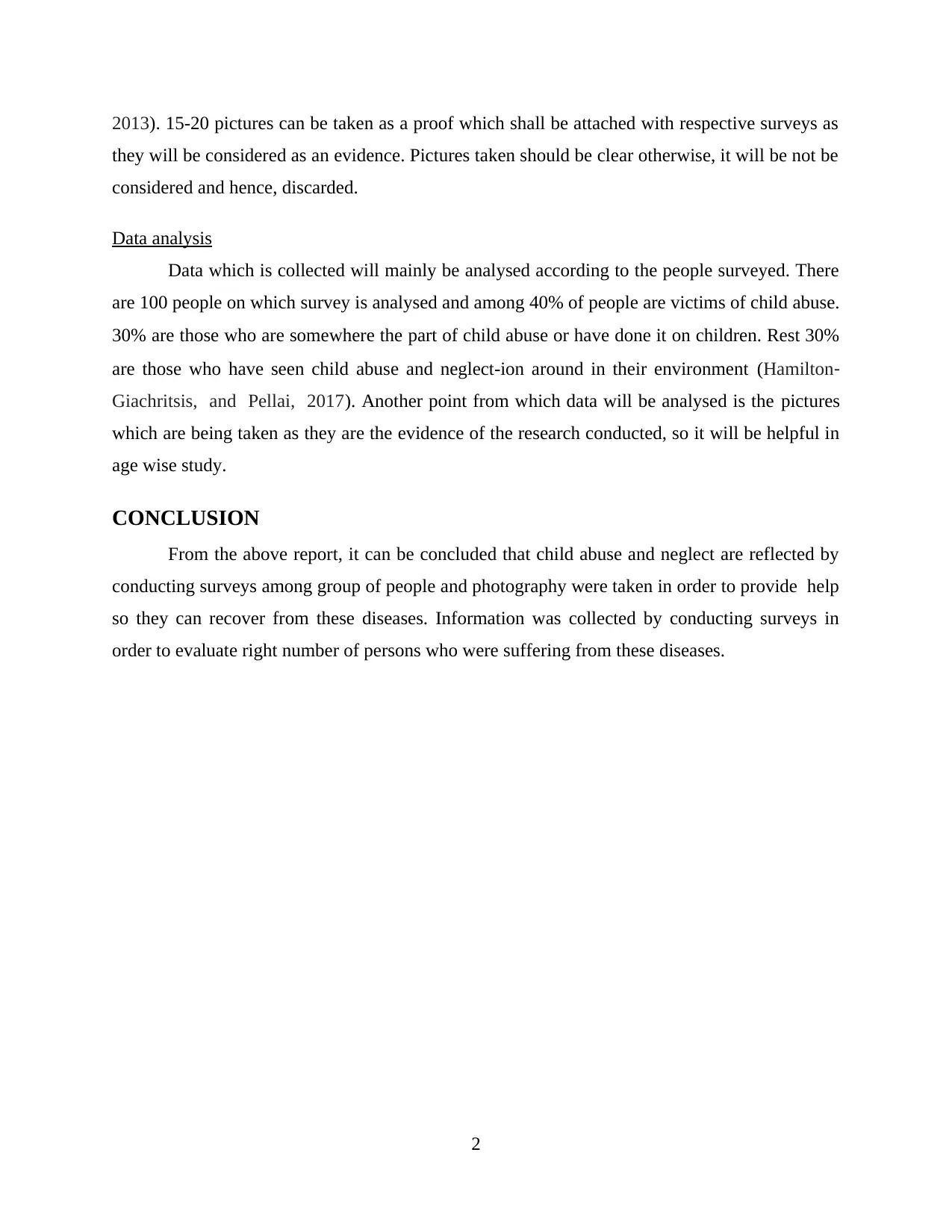
2013). 15-20 pictures can be taken as a proof which shall be attached with respective surveys as
they will be considered as an evidence. Pictures taken should be clear otherwise, it will be not be
considered and hence, discarded.
Data analysis
Data which is collected will mainly be analysed according to the people surveyed. There
are 100 people on which survey is analysed and among 40% of people are victims of child abuse.
30% are those who are somewhere the part of child abuse or have done it on children. Rest 30%
are those who have seen child abuse and neglect-ion around in their environment (Hamilton‐
Giachritsis, and Pellai, 2017). Another point from which data will be analysed is the pictures
which are being taken as they are the evidence of the research conducted, so it will be helpful in
age wise study.
CONCLUSION
From the above report, it can be concluded that child abuse and neglect are reflected by
conducting surveys among group of people and photography were taken in order to provide help
so they can recover from these diseases. Information was collected by conducting surveys in
order to evaluate right number of persons who were suffering from these diseases.
2
they will be considered as an evidence. Pictures taken should be clear otherwise, it will be not be
considered and hence, discarded.
Data analysis
Data which is collected will mainly be analysed according to the people surveyed. There
are 100 people on which survey is analysed and among 40% of people are victims of child abuse.
30% are those who are somewhere the part of child abuse or have done it on children. Rest 30%
are those who have seen child abuse and neglect-ion around in their environment (Hamilton‐
Giachritsis, and Pellai, 2017). Another point from which data will be analysed is the pictures
which are being taken as they are the evidence of the research conducted, so it will be helpful in
age wise study.
CONCLUSION
From the above report, it can be concluded that child abuse and neglect are reflected by
conducting surveys among group of people and photography were taken in order to provide help
so they can recover from these diseases. Information was collected by conducting surveys in
order to evaluate right number of persons who were suffering from these diseases.
2
Paraphrase This Document
Need a fresh take? Get an instant paraphrase of this document with our AI Paraphraser
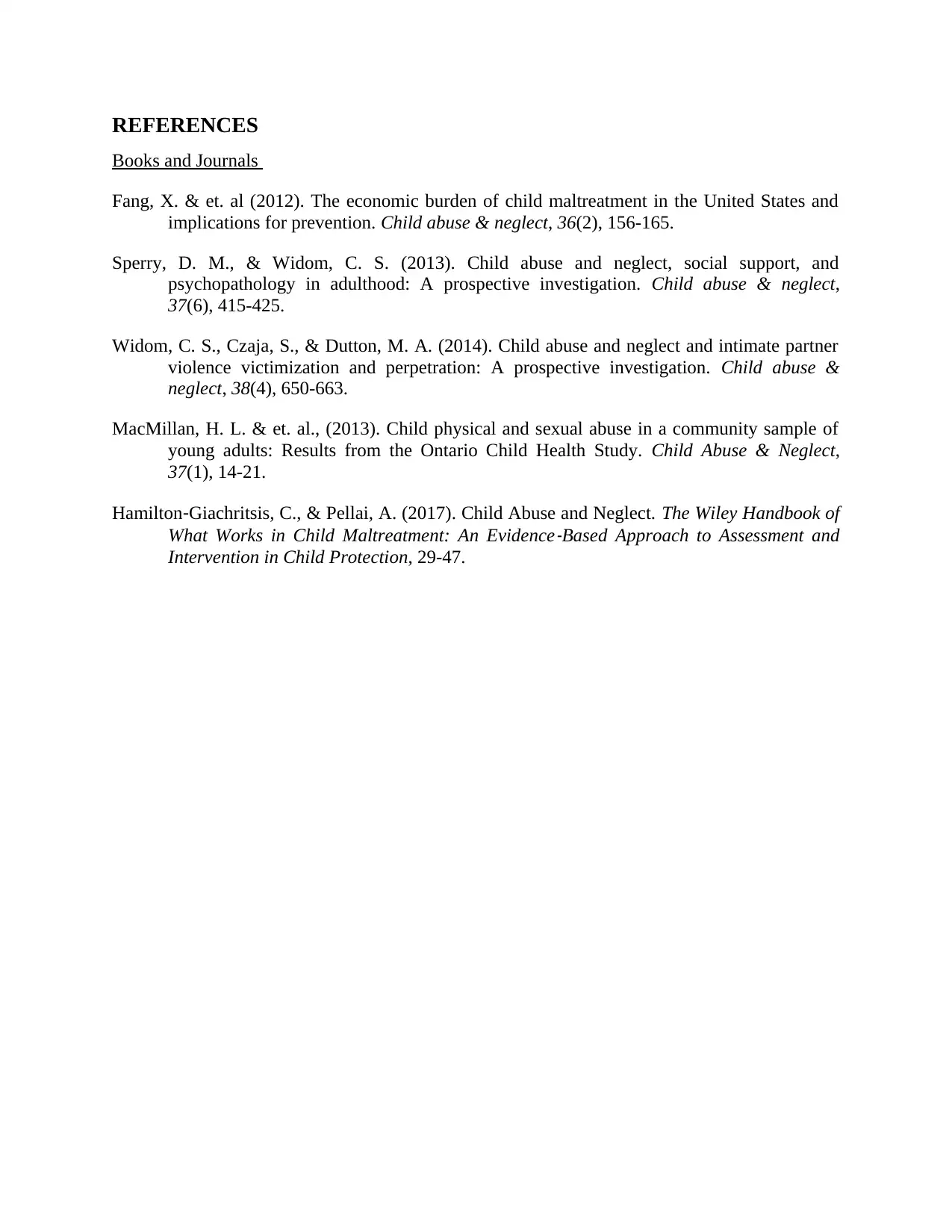
REFERENCES
Books and Journals
Fang, X. & et. al (2012). The economic burden of child maltreatment in the United States and
implications for prevention. Child abuse & neglect, 36(2), 156-165.
Sperry, D. M., & Widom, C. S. (2013). Child abuse and neglect, social support, and
psychopathology in adulthood: A prospective investigation. Child abuse & neglect,
37(6), 415-425.
Widom, C. S., Czaja, S., & Dutton, M. A. (2014). Child abuse and neglect and intimate partner
violence victimization and perpetration: A prospective investigation. Child abuse &
neglect, 38(4), 650-663.
MacMillan, H. L. & et. al., (2013). Child physical and sexual abuse in a community sample of
young adults: Results from the Ontario Child Health Study. Child Abuse & Neglect,
37(1), 14-21.
Hamilton‐Giachritsis, C., & Pellai, A. (2017). Child Abuse and Neglect. The Wiley Handbook of
What Works in Child Maltreatment: An Evidence
‐Based Approach to Assessment and
Intervention in Child Protection, 29-47.
Books and Journals
Fang, X. & et. al (2012). The economic burden of child maltreatment in the United States and
implications for prevention. Child abuse & neglect, 36(2), 156-165.
Sperry, D. M., & Widom, C. S. (2013). Child abuse and neglect, social support, and
psychopathology in adulthood: A prospective investigation. Child abuse & neglect,
37(6), 415-425.
Widom, C. S., Czaja, S., & Dutton, M. A. (2014). Child abuse and neglect and intimate partner
violence victimization and perpetration: A prospective investigation. Child abuse &
neglect, 38(4), 650-663.
MacMillan, H. L. & et. al., (2013). Child physical and sexual abuse in a community sample of
young adults: Results from the Ontario Child Health Study. Child Abuse & Neglect,
37(1), 14-21.
Hamilton‐Giachritsis, C., & Pellai, A. (2017). Child Abuse and Neglect. The Wiley Handbook of
What Works in Child Maltreatment: An Evidence
‐Based Approach to Assessment and
Intervention in Child Protection, 29-47.
1 out of 5
Related Documents
Your All-in-One AI-Powered Toolkit for Academic Success.
+13062052269
info@desklib.com
Available 24*7 on WhatsApp / Email
![[object Object]](/_next/static/media/star-bottom.7253800d.svg)
Unlock your academic potential
Copyright © 2020–2025 A2Z Services. All Rights Reserved. Developed and managed by ZUCOL.



